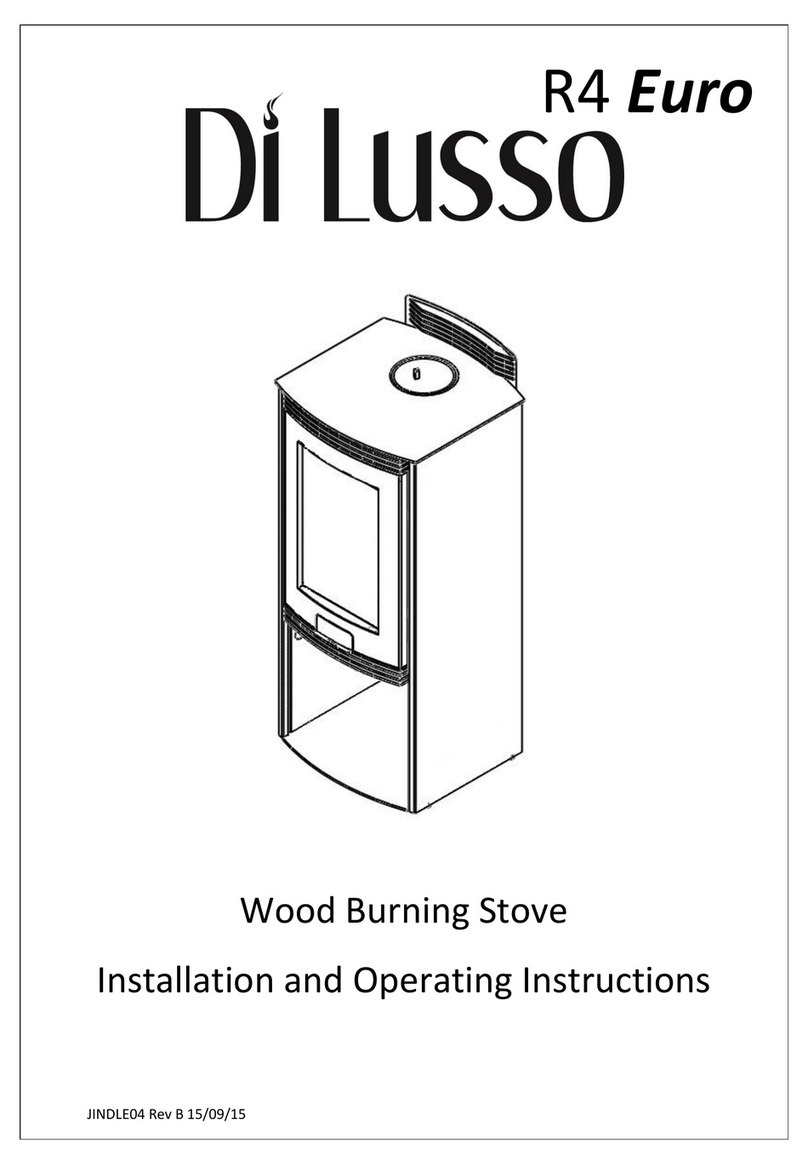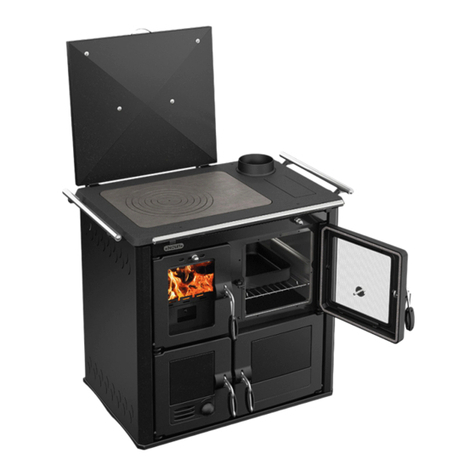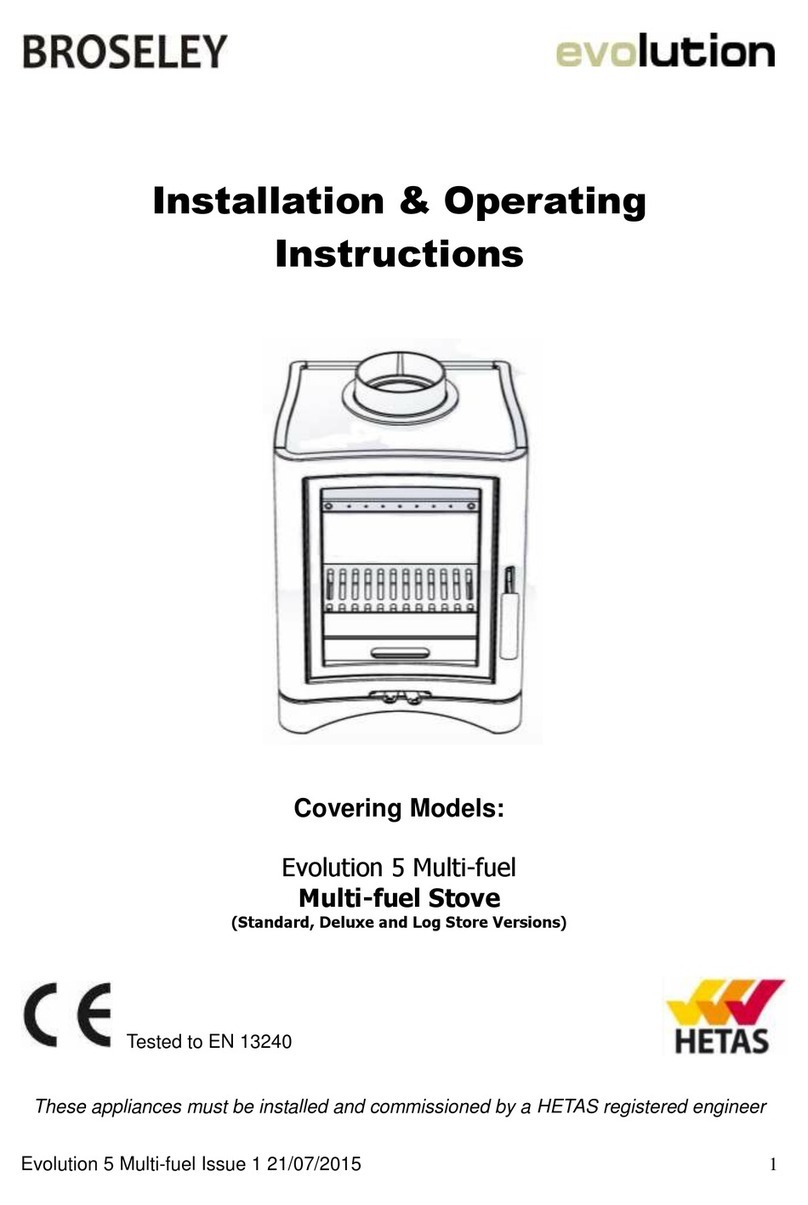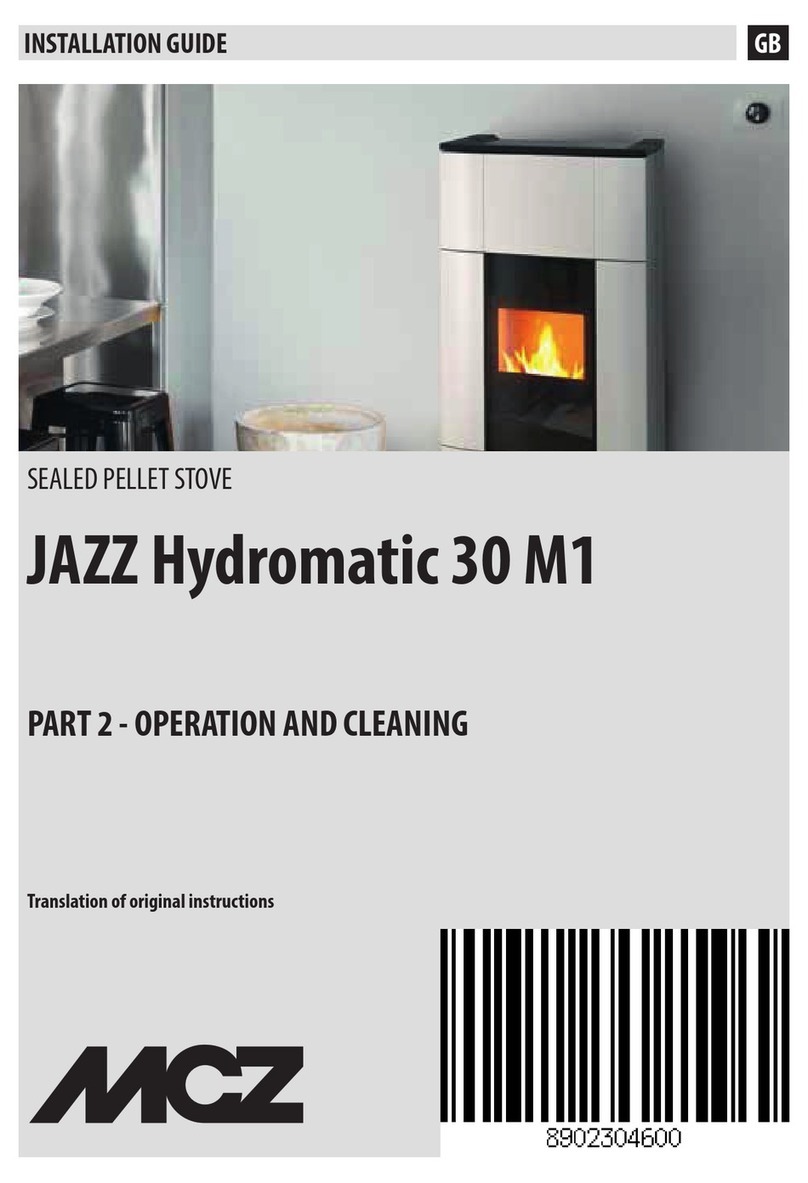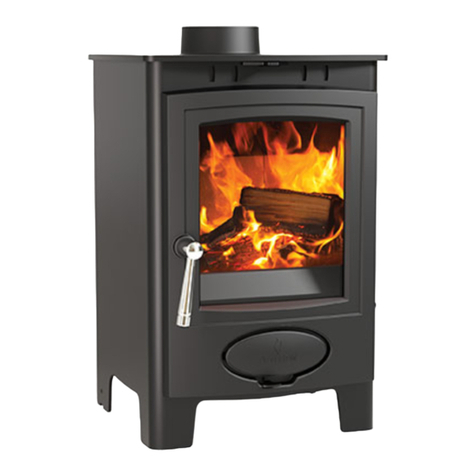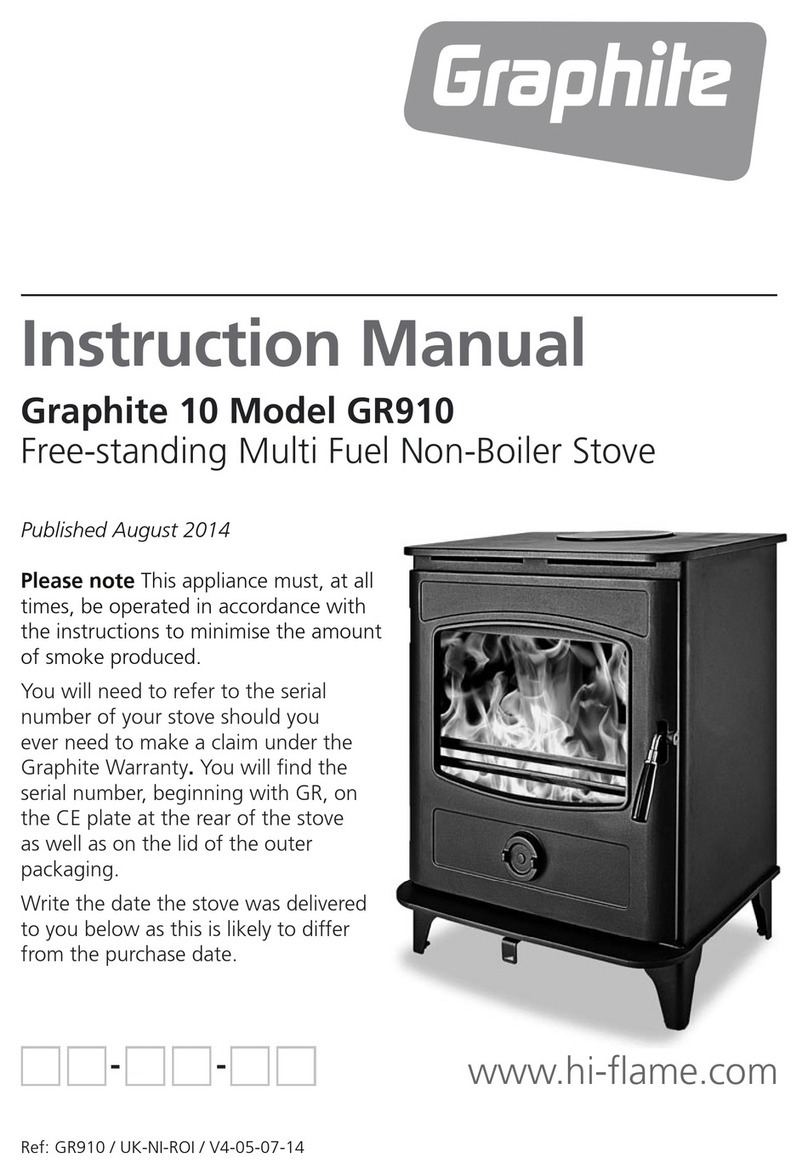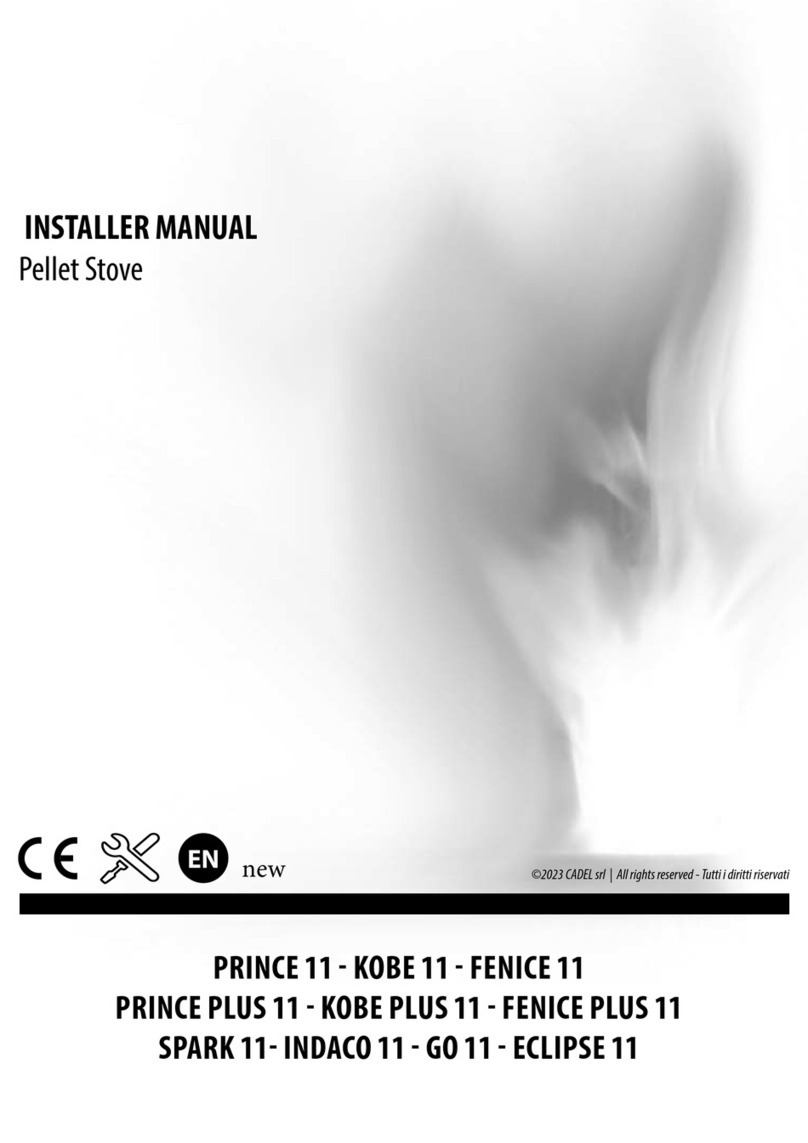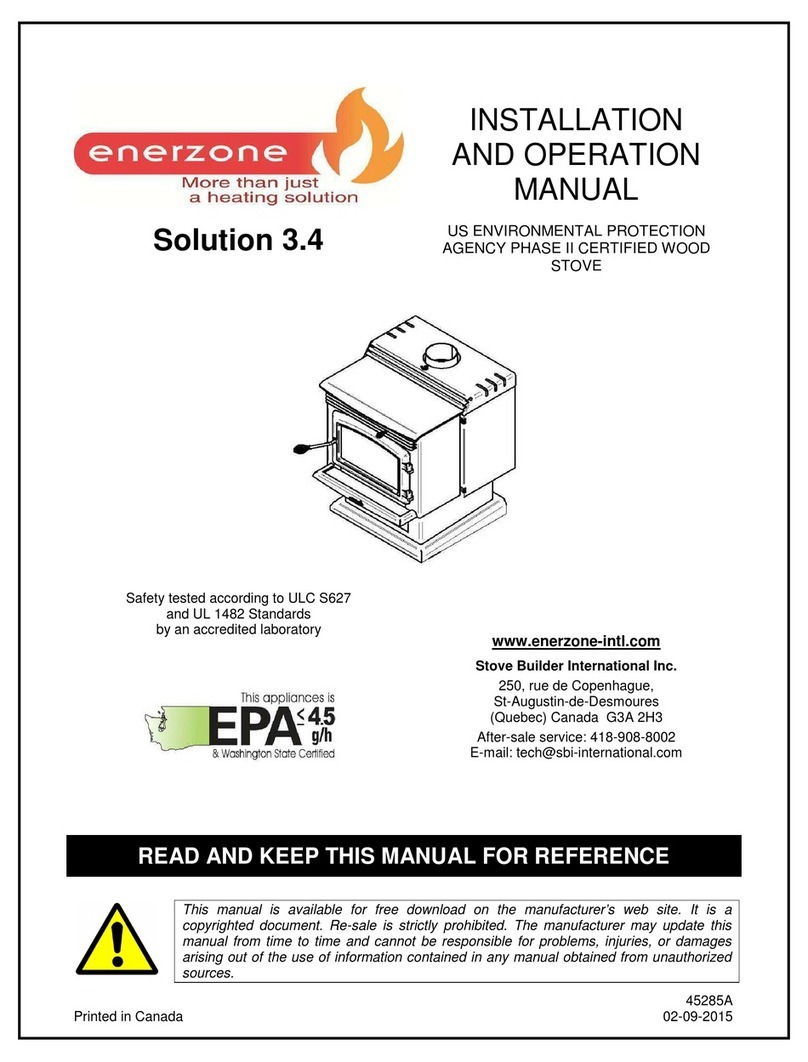diLUSSO R4 User manual

JINDLU04 Rev E 14/01/15
Wood Burning Inset Stove
Installation and O erating Instructions
R4

JINDLU04 Rev E 14/01/15
This a liance is not suitable for use in a shared flue
This a liance is suitable for intermittent burning
Smoke Control Areas
This a liance is only exem t for use in a smoke control area when fitted
with a smoke control area kit (JDLU0401)
Find out if you are in a Smoke Control Area by contacting your Local
Authority
Di Lusso, Em eror Way, Exeter Business Park, Exeter, United
Kingdom, EX1 3QS
DSEN13229 – Inset Wood Burning Stove
A liance Mass 70kg
Efficiency 79%
Nominal Heat Out ut 4.9kW
Mean Co Emission (@13% O
2
) 0.09%
Mean OGC Emission (@13% O
2
) 99 mg/m
3
n
Mean NO
x
(as NO
2
) 35 mg/m
3
n
Mean Flue Gas Tem erature 226°C
Flue Gas Mass Flow 5.5g/sec
Particulates (@13% O
2
) 13mg/m
3
n
NS3058/59
Average Particulate Emission 2.12g/kg
Maximum Particulate Emission 2.35g/kg
Combustion Air Requirement 17.5m³/hr
Minimum Clearance to Combustible Material
At the sides of the stove 250mm (from outside of frame)
In front of the stove (to furniture etc) 800mm
R4
11

JINDLU04 Rev E 14/01/15
Guarantee
The Body of the stove is covered under a 5
year guarantee (from date of urchase) to be
free from defects in materials and
workmanshi . Internal com onents other
than consumable items such as glass and
firebricks are covered for a eriod of one year
from date of urchase.
General Guidance
It is im ortant that your stove is correctly
installed as Di Lusso cannot acce t
res onsibility for any fault arising through
incorrect use or installation.
These instructions cover the basic rinci les
to ensure satisfactory installation of the stove,
although detail may need slight modification
to suit articular local site conditions.
The installation must com ly with current
Building Regulations, national and Euro ean
standards, Local Authority byelaws and other
s ecifications or regulations as they affect the
installation of the stove.
The Building Regulations requirements may
also be met by ado ting the relevant
recommendations in the current issues of
British Standards BS 8303 and BS EN 15287-1.
C
OMPETENT
P
ERSONS
S
CHEME
Di Lusso recommend that this stove is
installed by a member of an accredited
com etent ersons scheme e.g. HETAS.
If the installer is not a member of a
com etent ersons scheme, it is a legal
requirement in the UK to notify your local
building control body in advance of any work
starting.
H
EALTH AND
S
AFETY
P
RECAUTIONS
S ecial care must be taken when installing the
stove such that the requirements of the
Health and Safety at Work Act are met.
P
AC AGING
All ackaging su lied with this stove can be
re-used or recycled. Please contact your local
authority for information on recycling
schemes in your area.
H
ANDLING
Adequate facilities must be available for
loading, unloading and site handling.
F
IRE
C
EMENT
Some ty es of fire cement are caustic and
should not be allowed to come into contact
with the skin. In case of contact, wash
immediately with lenty of water.
A
SBESTOS
This stove contains no asbestos. If there is a
ossibility of disturbing any asbestos in the
course of installation then lease seek
s ecialist guidance and use a ro riate
rotective equi ment.
M
ETAL
P
ARTS
When installing or servicing this stove, care
should be taken to avoid the ossibility of
ersonal injury.
A
IR
S
UPPLY
The room or s ace containing this a liance
should have ur ose rovided ventilation
(where necessary) in accordance with Building
Regulations.
Due consideration should be given to air
requirements for any other a liance in the
same room or s ace.
Any air o ening must be ke t clear from
blockage or obstruction.
M
ODIFICATION
No unauthorized modification of this
a liance should be carried out.

JINDLU04 Rev E 14/01/15
S
AFETY
WARNING – This a liance will be hot when
in o eration and due care should be taken.
The su lied o erating tool or gloves may be
used to o en the door and o erate the air
controls.
AEROSOLS – Do not use an aerosol s ray on
or near the stove when it is alight.
FIRES CAN BE DANGEROUS – Always use a
fireguard in the resence of children, the
elderly or the infirm. The fireguard should be
manufactured in accordance with BS8423 –
Fireguards for use with solid fuel a liances.
DO NOT OVER-FIRE – it is ossible to fire the
stove beyond its design ca acity. This could
damage the stove so watch for signs of over-
firing. If any art of the stove starts to glow
red, the stove is in an over-fire situation and
the controls should be adjusted accordingly.
Never leave the stove unattended for long
eriods without first adjusting the controls to
a safe setting. Careful air su ly control
should be exercised at all times.
FUME EMISSION – ro erly installed and
o erated, this a liance will not emit fumes.
Occasional fumes from de-ashing and
refueling may occur. Persistent fume emission
must not be tolerated.
This appliance sho ld not be operated with
the doors open
If fume emission does ersist then the
following action should be taken immediately
–
•O en Doors and windows to ventilate
room.
•Let the fire out, or eject and safely
dis ose of fuel from the a liance.
•Check for flue/chimney blockage and
clean if required.
•Do not attem t to relight the fire until
the cause has been identified and
corrected.
•If necessary seek rofessional advice.
ADVERSE WEATHER – In a small number of
installations, occasional local weather
conditions (e.g. wind from a articular
direction) may cause downdraught in the flue
and the stove to emit fumes. In these
circumstances the stove should not be used. A
rofessional flue installer will be able to
advise on solutions to this roblem (e.g. anti-
downdraught cowl).
EXTRACTOR FANS – DO NOT FIT AN
EXTRACTOR FAN IN THE SAME ROOM AS
THIS APPLIANCE.
IN THE EVENT OF A CHIMNEY FIRE -
•Raise the alarm
•Call the Fire Brigade
•Close a liance air controls
•Move furniture, ornaments etc away
•Place a fireguard in front of stove
•Check the chimney breast for signs of
excessive heat.
If the wall is becoming excessively hot, move
furniture away. Ensure the Fire Brigade can
gain access to your roof s ace in order to
check for fire s read.

JINDLU04 Rev E 14/01/15
Installation
(N.B. All dimensions are in Millimetres)
A
PPLIANCE
D
IMENSIONS
F
LUE OUTLET POSITION
The flue outlet angle and osition is
determined by the orientation of the flue
collar. The outlet can be either vertical or
leant backwards by 30°. To change the angle,
rotate the flue collar by 180°. The effective
centre dimensions in millimeters are shown
below.
A
PPLIANCE
O
PENING
This stove must be fitted on a hearth or base
with adequate load-bearing ca acity.
The o ening into which this stove is fitted
should be constructed wholly from non-
combustible materials. The dimensions of the
o ening should be at least those shown in the
diagram. Ensure there is a sufficient overla
where the convection chamber flange meets
the face of the o ening. If not, either the
o ening should be made smaller, or a suitable
fire surround should be fitted to reduce the
o ening dimensions.
This a liance will fit into a standard 16”
fire lace o ening if the clay fireback is
removed.
Any non-comb stible walls within 50mm of
this appliance sho ld be at least 200mm
thick and sho ld extend at least 300mm
above the top of the appliance and at least
1.2 metres above the hearth. Any walls more
than 50mm from the appliance may be
red ced to a thickness of 75mm. Ens re the
inter-connecting fl e pipe also has adeq ate
clearances to comb stible materials.

JINDLU04 Rev E 14/01/15
The wall above the stove will become hot and
should therefore be finished in a heat
resistant laster. IMPORTANT Do not hang
pict res, electrical eq ipment or ornaments
above the stove, as these co ld be damaged
and co ld potentially create a fire hazard.
Please check the s itability of any
fireplace/s rro nd for closed solid f el
appliances before installation. Di L sso
cannot be held responsible for any fa lt
arising thro gh incorrect se or installation.
Fire s rro nd back panels s itable for solid
f el are s ally in three sections and
slabbed. Many fire s rro nds are s itable
only for se with gas and electric fires and
therefore not s itable for solid f el.
D
IRECT
A
IR
A
DAPTOR
If fitting the direct air ada tor kit the o ening
de th may need to be increased. Read the
instructions su lied with the kit before
roceeding.
H
EARTH
R
EQUIREMENTS
A constructional hearth with a minimum
thickness of 125mm should be rovided. The
constructional hearth should be made of solid
non-combustible material and can include any
solid non-combustible floor. The boundary of
the hearth must be clearly marked. This can
be done by adding a su er-im osed hearth on
to of the constructional hearth – e.g. a slate
slab on to of a solid concrete floor.
A liances installed with the base late lower
than 300mm above the hearth should have a
constructional hearth extending to at least
400mm in front of the stove and 150mm at
the sides.
A liances installed on a surface more than
300mm above the hearth require a
constructional hearth with a de th of 225mm
in front of the stove. The base on which the
a liance is mounted should be an extension
of the constructional hearth – i.e. all material
between the stove base and the
constr ctional hearth m st be solid-non
comb stible material.

JINDLU04 Rev E 14/01/15
C
LEARANCES TO
C
OMBUSTIBLE
M
ATERIALS
There should be no combustible materials for
a distance of 250mm either side of the stove
or 680mm above. No combustible furniture
should be laced any closer than 800mm from
the front of the stove.
Allow s fficient clearance between the stove
and pict res, electrical eq ipment or
ornaments etc, as these co ld be damaged
and co ld potentially create a fire hazard.
F
LUE
R
EQUIREMENTS
The flue serving this a liance must be dry,
free from cracks and obstructions and be in
accordance with the designations shown in
Table 1.
The diameter of the flue should not be less
than 127mm and not more than 200mm.
If these requirements are not met the
chimney should be lined by a suitable
method.
If there is no existing chimney then either a
refabricated block chimney in accordance
with Building Regulations A roved
Document J or a twin-walled insulated
stainless steel flue to BS EN 1856 can be used.
These chimneys must be fitted in accordance
with the manufacturer’s instructions and
Building Regulations.
Fl e Type
Minim m Designation
Masonry or flue block
flue with liner
T400 N2 D3 G
(BS EN 1443:2003)
Clay Flue Blocks
FB1 N2
(BS EN 1806:2006)
Clay/Ceramic Liners
B1 N2
(BS EN 1457:2009)
Concr
ete Liners
B2
(BS EN 1857:2003)
Factory Made Metal
Chimney
T400 N2 D3 G
(BS EN 1856-1:2003)
The chimney/flue should have a vertical
height of at least 4.5 metres and should
terminate in accordance with Table 2.
If the chimney is believed to have reviously
served an o en fire installation, it is ossible
that the higher flue gas tem erature from the
stove may loosen de osits that were
reviously firmly adhered, with the
consequent risk of flue blockage. It is
therefore recommended that the chimney is
swe t a second time within a month of
regular use after installation.
Table 1
–
Minimum Flue Designations

JINDLU04 Rev E 14/01/15
If yo have any do bts abo t the s itability
of yo r chimney, cons lt yo r local
dealer/stockist.
Both the chimney and fl e pipe m st be
accessible for cleaning and if ANY part of the
chimney cannot be reached thro gh the
stove (with baffle removed), a soot door
m st be fitted in a s itable position.
F
LUE
D
RAUGHT
If the draught exceeds the recommended
maximum, a draught stabiliser must be fitted
so that the rate of burning can be controlled
and to revent over firing.
If the reading is less than the recommended
minimum then the erformance of the
a liance will be com romised.
The flue draught should be checked under fire
at high out ut.
Minim m Dra ght – 1.2mm Water Ga ge
Maxim m Dra ght – 2.5mm Water Ga ge
R
EMOVING INTERNAL COMPONENTS
All internal components m st be removed
prior to fitting the stove. This will make
handling the stove easier; allow access to
fixings and the fl e o tlet; as well as protect
the internal components from damage
d ring the installation process.
1. To o en the stove door, ress on the
door lever to release it from the latch.
Swing the handle out to the right until
the mechanism engages and the door
catch is released.
N.B.
When closing the door keep the door handle
o t to the right ntil the door is closed.
Terminal Position
Clearances to Fl e
O tlet
a
At or within
600mm of
the ridge
At least
600m above the ridge
b
Elsewhere
on a roof
(whether
itched or
flat)
At least 2300mm horizontally
from the nearest oint on the
weather surface and:
a) At least 1000mm above
the highest oint of
intersection of the
chimney and the weather
surface or
b) At least as high as the ridge
c
Below (on a
itched
roof) or
within
2300mm
horizontally
to an
o enable
rooflight,
dormer
window or
other
o ening.
At least 1000mm above the to
of the o ening.
d
Within
2300mm of
an adjoining
or adjacent
building,
whether or
not beyond
the
boundary.
At least 600mm above any art
of the adjacent building within
2300mm
Table 2
-
Flue terminal positions

JINDLU04 Rev E 14/01/15
2. Remove the log retainer by lifting it
clear of the two su ort ins.
3. Remove the baffle brick by lifting it
u , sliding it to the right and then
lowering the left hand edge into the
firebox.
4. Remove the two side bricks by lifting
them u to release them from the
slots in the base brick. Swing the
bricks into the centre and remove
them from the stove.
5. Remove the three rear brick sections
noting their ositions and orientation.
6. Lift u and remove the base brick.
7. Remove the Air Valve Cassette by
removing the socket screw holding it
in lace, turning both air controls to
the fully o en osition (clockwise)
and then gently ulling on the fascia
to slide the cassette out from under
the firebox. N.B. DO NOT Remove the
Air Valve Cassette with the controls
in the closed position as this will
damage the valve gaskets.
Socket screw

JINDLU04 Rev E 14/01/15
8. Undo the four countersunk screws
and remove the base fixing access
late and gasket.
F
ITTING THE
S
TOVE
IMPORTANT – Read this section caref lly and
ens re that any req ired access holes,
register plates or fl e connections are in
place before carrying o t the installation.
If the installation is to be back filled with
vermic lite concrete the convection chamber
flange sho ld be sealed to the fireplace sing
fire cement, heat proof silicone or similar. All
seams in the convection chamber sho ld also
be sealed.
It is recommended that the convection
chamber flange is sealed to the fireplace in
all cases as this will red ce the chance of
airflow into any voids red cing the stoves
efficiency or the ingress of npleasant smells
into the room.
If fitting the Direct Air Adaptor Kit the
instr ctions s pplied with the kit sho ld be
read in conj nction with these instr ctions.
1. Offer the stove into osition in the
recess ushing it back far enough so
that the flanges on the edge of the
convection chamber are ushed u
tightly against the front of the
chimney breast/fire lace.
2. Drill a 6mm hole into the hearth in
the centre of the base late fixing
hole. Use the screw su lied to fix
the stove in lace.
Any voids aro nd the stove m st be In-filled
with vermic lite concrete with a
recommended mix of six parts vermic lite to
one part Ordinary Portland Cement. This may
be carried o t once the fl e has been fitted
provided a s itable access hole for backfilling
is made in the chimney breast (see section on
connecting to a masonry chimney). S fficient
water sho ld be added so that when a
handf l of the mixt re is sq eezed no more
than one or two drops of water are released.
F
LUE CONNECTION
The fl e collar can be connected to the stove
after the stove has been p t into position.
Make s re the gasket is fitted over the fl e
collar before making any connection to the
fl e liner or fl e pipe.
If connecting to a stainless steel liner, the flue
liner and single skin ada tor can be lowered
down the chimney and the s igot end of the
ada tor lowered into the firebox.
The flue collar can then be connected to the
ada tor.
The com leted flue collar assembly can then
be ushed u to the to late of the stove
and secured in osition using the four M8
nuts and washers. Check the clearance of the
flue liner ada tor through the to of the stove
before deciding on this method.

JINDLU04 Rev E 14/01/15
If connecting to an existing masonry chimney
it is recommended that a flue forming i e
(short length of flue i e) is used and the void
between the flue forming i e and the
chimney filled with vermiculite concrete.
A suitable access hole will need to be made in
the chimney breast to allow the back filling to
be carried out and then filled and sealed once
the installation is com lete.
Alternatively a connection can be made using
a register late although it will be necessary
to allow access for fitting the flue i e to the
register late and sealing all joints.
R
E
-A
SSEMBLING
T
HE
S
TOVE
1. Refit the base fixing access late and
gasket, Air Valve Cassette (with the air
controls set to maximum), firebricks,
brick baffle and log retainer.
2. Wind the M6 Nuts to the ends of the
studs on the convection chamber
sides.
3. Slide the Frame in to osition and
tighten the nuts with a 10mm
s anner.

JINDLU04 Rev E 14/01/15
4. Release the door catch and hold the
door ajar.
5. Offer the Door Fascia into osition,
assing the 3x M6 studs through the
holes in the door and fix in osition
using the nuts and washers rovided.
6. Close the door and check the
alignment of the Door Fascia with the
frame. Adjust as necessary.
7. Attach the door handle to the door
lever using the M6 screws and
washers. Check the alignment of the
handle with the door fascia and adjust
as necessary. The door handle sho ld
be fl sh with the fascia and have an
even gap aro nd it when in the
closed position.
C
OMMISSIONING
U on com letion of the installation allow a
suitable eriod of time for any fire cement
and mortar to dry out. A small fire may then
be lit and the installation checked to ensure
the smoke and fumes are drawn u the flue
and emitted safely to atmos here. The stove
should not be run at full out ut for at least 24
hours. Read the Operating Instr ctions
before lighting the stove for the first time.
Leave the instructions and o erating tool(s)
with the customer and advise them on -
•Correct use of the a liance
•The recommended fuel
•Action to be taken should smoke or
fumes be emitted from the stove or
installation.
•The use of a fireguard when the stove
is used in the resence of children or
the infirm.

JINDLU04 Rev E 14/01/15
O erating Instructions
Read the ‘General G idance’ Section at the
start of these instr ctions before operating
yo r stove for the first time.
IMPORTANT! - Do not hang pict res,
televisions or comb stible ornaments above
the stove, as these co ld be damaged and
co ld potentially create a fire hazard (For
more information read the ‘Clearance
Distances to Comb stibles’ section of the
installation instr ctions).
WARNING! – This appliance will be hot when
in operation and d e care sho ld be taken.
The s pplied operating tool or gloves may be
sed to open the door and operate the air
controls.
R
ECOMMENDED
F
UEL
This a liance is designed and a roved to
burn wood logs with a moisture content not
exceeding 20%. The maximum recommended
log length is 250mm (10”) and the maximum
recommended log diameter is 100mm (4”).
Burn only dry, well seasoned wood, which
should have been cut, s lit and stacked for at
least 12 months, with free air movement
around the sides of the stack to enable it to
dry out. Burning wet or unseasoned wood will
create tar de osits in the stove and chimney,
increase harmful emissions and will not
roduce a satisfactory heat out ut.
Do not b rn waste, mineral f el, or treated
or painted wood in this appliance.
A
IR
C
ONTROLS
Installed and sed correctly this stove will
b rn cleanly and efficiently. Therefore, to
avoid the disappointment of poor
performance or dirty glass, please familiarize
yo rself with the controls and their
recommended settings before se.
To access the air controls ress on the door
handle to release it from the latch and swing
it to the right.
If the door handle is sw ng past the point
where resistance is felt the door will be
nlatched and may swing open.
When the stove is hot the door handle can be
released by ressing the end of the o erating
tool against the arm below the handle. This
will revent damage to the aint.
Alternatively a glove can be used.
Ignition Air control – regulates air flow
directly into the firebed. This is used when
lighting from cold or when reviving a fire that
has nearly burnt out. Turn clockwise to o en
and anti- clockwise to close. The Ignition Air
Control m st be closed once the fire is
established.
Comb stion Air Co
ntrol
Ignition Air Control

JINDLU04 Rev E 14/01/15
Comb stion Air Control – regulates the flow
of air downwards into the combustion
chamber via the airwash (airflow over the
inside of the glass) and the tertiary air inlet
(air inlet holes in the back of the firebox). Turn
clockwise to o en and anti-clockwise to close.
This control is sed to reg late the b rn rate
and therefore heat o tp t of the stove.
O
PENING THE
S
TOVE
D
OOR
To o en the stove door ress on the door
handle to release it from the latch. Swing the
handle out to the right until the mechanism
engages and the door catch is released.
N.B. When closing the door keep the door
handle o t to the right ntil the door is
closed.
L
IGHTING
We recommend that yo have two or three
small fires before yo operate yo r stove to
its maxim m heat o tp t. This is to allow the
paint to c re in steadily and to give a long
service life to the paint finish. D ring this
c ring in process yo may notice an
npleasant smell. It is non-toxic, b t for yo r
comfort we wo ld s ggest that d ring this
period yo leave all doors and windows
open.
O en both air controls fully and light one or
two firelighters laced centrally on the
bottom of the firebox, allowing the flames to
become established before lacing several
ieces of small dry kindling in a criss-cross
fashion above the firelighters, taking care not
to smother the fire. Close the stove door.
Once the kindling is well alight o en the door
and build the fire by gradually adding slightly
larger ieces of wood, closing the door
afterwards.
Once the fire is established close the Ignition
Air Control (anti-clockwise) and add more fuel
as necessary. The Combustion Air control can
now be used to regulate the burn rate of the
stove (see Recommended Settings).
Sho ld the fire fail to light correctly o en the
door and use a oker to s read the fuel across
the bottom of the firebox. Close the door and
allow the fuel and stove to cool before
attem ting to relight the fire.
N.B. Leaving the air controls in the closed
osition, adding too much fuel or using wood
that is wet or too large will revent the fire
from establishing correctly and may result in
smoke emission from the stove.
When the stove is u to o erating
tem erature the o erating tool or gloves
should be used to o erate the air controls.
R
ECOMMENDED
S
ETTINGS
Once the fire is established the Ignition Air
Control should be fully closed and the
Combustion Air Control turned to a setting of
a roximately 50 -60% o en. This setting
should allow the nominal out ut and
efficiency to be achieved.
Avoid r nning the stove on very low air
settings as this co ld res lt in a red ction in
efficiency and increase emissions into the
atmosphere.
REFUELLING
Avoid refueling on to a low firebed as this may
cause excessive smoke emission. Ensure there
are sufficient embers to ignite the new fuel
load ra idly. Alternatively add some more
kindling before adding larger ieces of
firewood.

JINDLU04 Rev E 14/01/15
Do not add firewood above the level of the
tertiary air inlet at the back of the stove.
Exceeding this amount can result in the
roduction of excessive smoke.
D
E
-A
SHING
From time to time it will be necessary to
remove excess ash from the firebox. This can
be done by lifting u the log retainer to
release it from its su orts and removing the
ash with a small shovel.
Maintenance
Important! –In order to ens re contin ed
compliance with c rrent B ilding
Reg lations, Local A thority Byelaws and the
Clean Air Act (if applicable), this appliance
req ires reg lar maintenance of the
following –
N.B. Refer to the ‘Removing Internal
Components’ section of the installation
instr ctions for details on how to remove
each component.
M
ONTHLY
Brick Baffle – this should be removed and
cleaned at least once a month to revent any
build u of soot or ash that could lead to
blocked flueways. With the baffle removed
the chimney can be swe t through the
a liance.
Firebricks- in normal use these can last for
many years. It is ossible, however, to
damage them if care is not taken when
refueling the stove. Check eriodically for
seriously cracked bricks, which can be
re laced with new, available from your
dealer.
Air Valve assette- this should be removed
and cleaned monthly to remove any ash that
may be in the controls. N.B. Make s re that
controls are in the maxim m position (f lly
clockwise) before removing the Air Valve
Cassette.
Glass Panel- clean the glass anel when cool
with a ro rietary glass cleaner. Highly
abrasive substances should be avoided as
these can scratch the glass and make
subsequent cleaning more difficult.
Rope – if the ro e around the door is
becoming detached use ro rietary ro e
adhesive to re-attach it. If the ro e is in oor
condition a re lacement ro e kit may be
ordered from the Di Lusso s ares range.
A
NNUALLY
Annual maintenance of the following should
be carried out by a com etent erson –
himney and flueways- it is im ortant that the
chimney, flueways and any connecting i e
are swe t regularly. This means at least twice
a year for Woodburning a liances. Only
wire-centred swee s’ brushes fitted with a
guide wheel should be used. If it is not
ossible to swee all arts of the chimney
through the a liance, ensure there is
adequate access to cleaning doors.
If the stove is fitted in lace of an o en fire
the chimney should be swe t one month after
installation to clear any soot falls which may
have occurred due to the difference in
combustion between the stove and the o en
fire.

JINDLU04 Rev E 14/01/15
P
ERIODS OF
P
ROLONGED
N
ON
-U
SE
If the stove is to be left unused for a
rolonged eriod, then it should be given a
thorough clean to remove ash and unburned
fuel residues. To enable a good flow of air
through the a liance to reduce condensation
and subsequent damage, leave the air
controls fully o en.
If the a liance has been unused for a long
eriod, such as during the s ring and summer
months, a com etent erson should check the
chimney for otential obstructions before
lighting the stove i.e. get the chimney swept
before the start of the heating season.
A
S
N
ECESSARY
Stove body – the stove is finished with a heat
resistant aint and this can be cleaned with a
soft brush. Do not clean the stove whilst it is
hot; wait until it has cooled down. The finish
can be renovated with ro rietary stove
aint.
Door atch – Over time the ro e seal in the
door will become com ressed. It may
therefore be necessary to adjust the door
catch to maintain the door seal. To adjust the
catch slacken the two set screws on the catch
bar and adjust the osition of the catch bar as
necessary.
Air Valves - Over time the sealing face of the
air valves may wear. This will reduce the
effectiveness of the controls. To re lace a
worn valve remove the air valve cassette, lift
off the worn valve and re lace with new.
Trouble Shooting
F
IRE WILL NOT BURN
Check that –
•The air inlet or slots in the front of the
stove are not obstructed in any way.
•Chimneys and flueways are clear.
•A suitable fuel is being used.
•There is an adequate air su ly into
the room.
•An extractor fan is not fitted in the
same room as the stove.
•Flue draught is above minimum level
(see installation instructions).
F
IRE BLAZING OUT OF CONTROL
Check that –
•The door is tightly closed.
•The air controls are in the closed
osition.
•A suitable fuel is being used.
•The glass is not loose.
•The door ro e seal is in good
condition.
•The air valve sealing faces are not
worn
•Flue draught is below maximum level
(see installation instructions).
Catch B
ar

JINDLU04 Rev E 14/01/15
Stove S ares
B
ODY
S
PARES

JINDLU04 Rev E 14/01/15
Stove S ares
D
OOR
S
PARES

JINDLU04 Rev E 14/01/15
Stove S ares
A
IR
V
ALVE
C
ASSETTE
S
PARES
Table of contents
Other diLUSSO Stove manuals
Popular Stove manuals by other brands
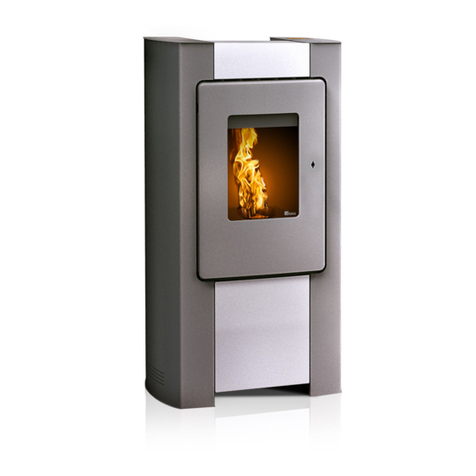
RIKA
RIKA Memo GSM Operating Manual

Dal Zotto
Dal Zotto LEYLA ELITE user manual

Heta
Heta SCAN-LINE 40 manual

Palazzetti
Palazzetti LINDA US 9 Installation and maintenance manual
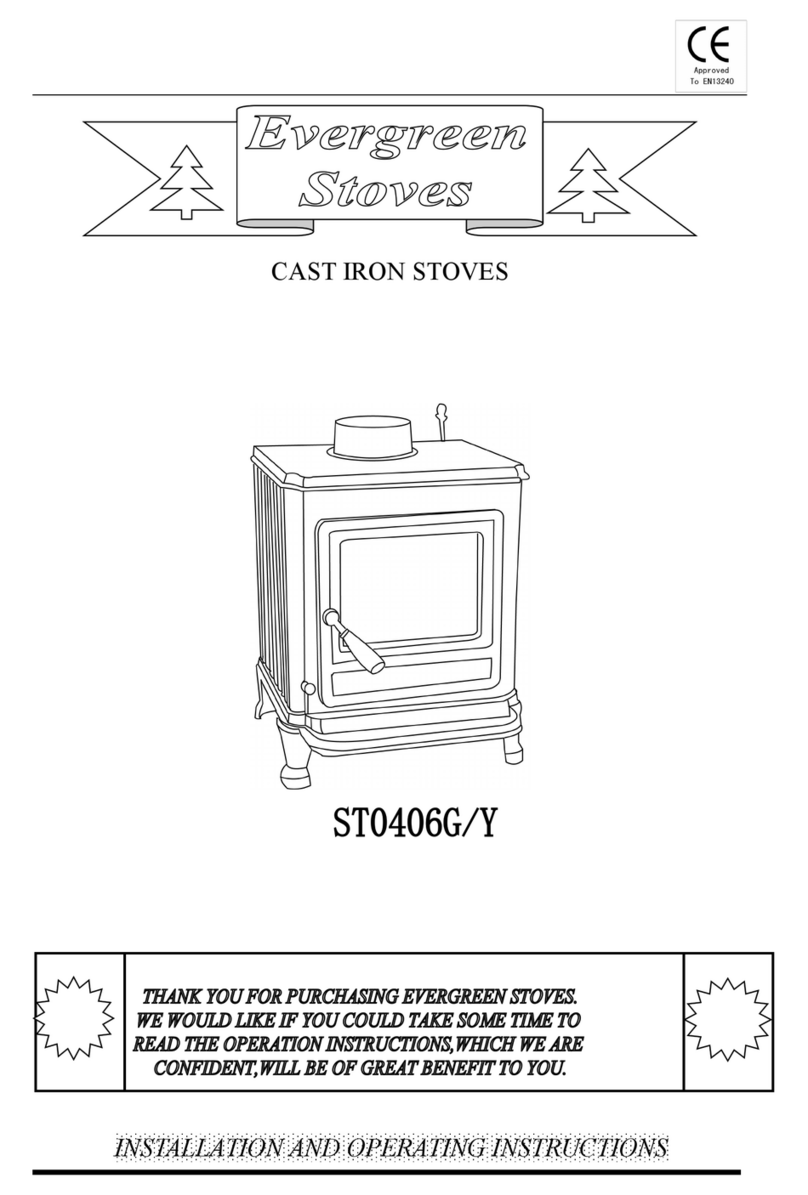
Evergreen Stoves
Evergreen Stoves ST0406G/Y Installation and operating instructions
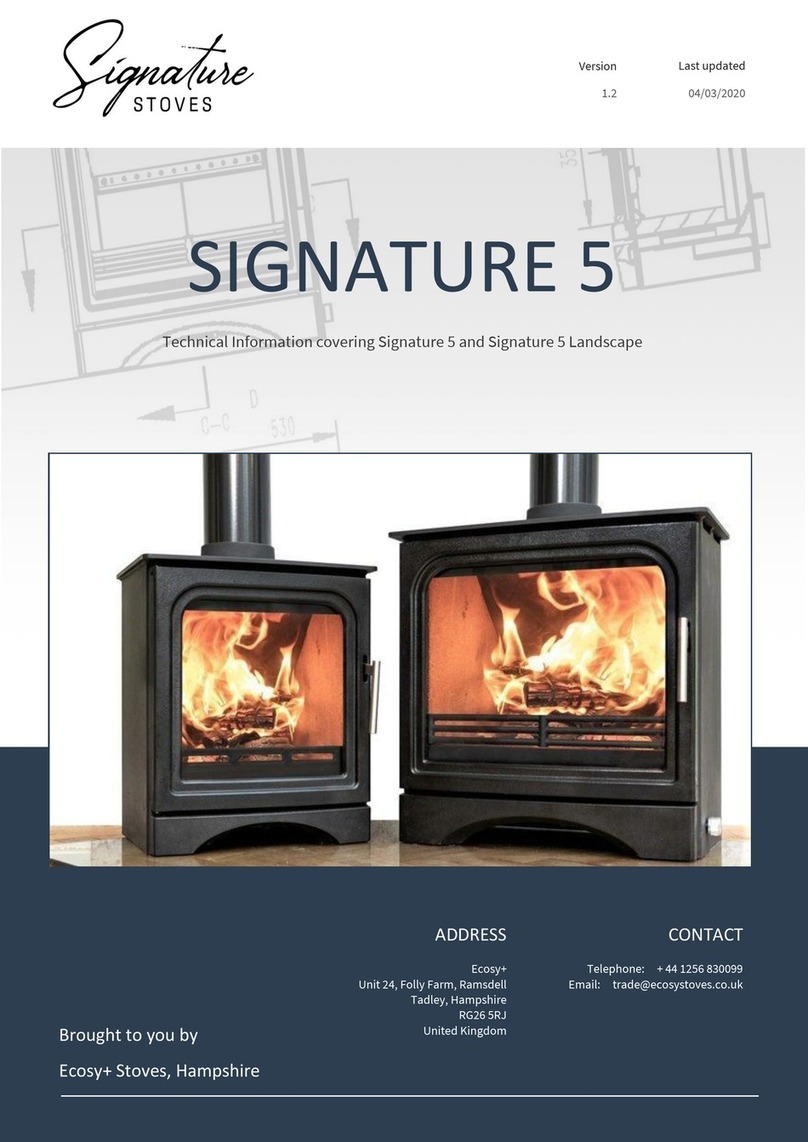
Signature
Signature Signature 5 technical information
